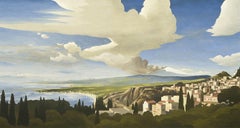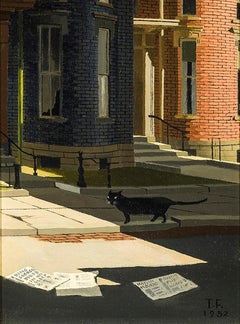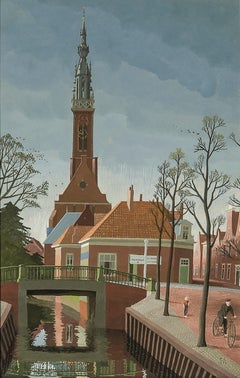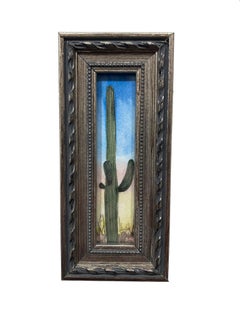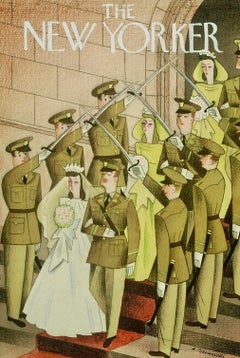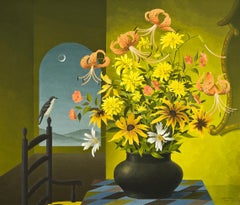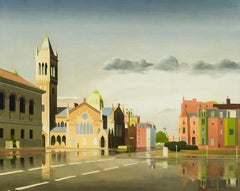Thomas Fransioli Art
to
2
1
Overall Width
to
Overall Height
to
3
2
1
2
1
1
1
1
1
1
1
1
1
1
1
1
1
1
1
1
3
2
2
2
1
3
7,820
5,167
2,504
1,501
3
Artist: Thomas Fransioli
Mt. Etna from Taormina
By Thomas Fransioli
Located in New York, NY
Thomas Fransioli, born in 1906 in Seattle, Washington, trained as an architect at the University of Pennsylvania. He worked as an architect before his service in World War II. Largel...
Category
20th Century American Realist Thomas Fransioli Art
Materials
Canvas, Oil
Street Scene: "King George Dies"
By Thomas Fransioli
Located in New York, NY
Fransioli was born in Seattle, Washington, and received a degree in architecture from the University of Pennsylvania in 1930. He worked with John Russell Pope on plans for the exhibition galleries at the National Gallery of Art in Washington, D.C., which he pinpointed as the beginning of his interest in painting. World War II interrupted a promising career in architecture. Fransioli served in the Pacific Theatre from 1943 until 1946, and was among the first American soldiers to survey Hiroshima after the atomic bomb’s detonation in August 1945. He returned to civilian life and took up painting, basing himself in Boston, but working up and down the eastern seaboard.
Thomas Fransioli’s cityscapes are crisp and tidy. Buildings stand in bold outline, their forms squarely defined by stark light and long shadows. Saturated color permeates every corner of his canvases, from vibrant oranges and greens to smoky terra cottas and granites. Even the trees that line Fransioli’s streets, parks, and squares are sharp and angular, exactly like those in an architect’s elevation rendering. But Fransioli’s cities often lack one critical feature: people. His streets are largely deserted, save for parked cars and an occasional black cat scurrying across the pavement. People make rare appearances in Fransioli’s compositions, and never does the entropy of a crowd overwhelm their prevailing sense of order and precision. People are implied in a Fransioli painting, but their physical presence would detract from the scene’s bleak and surreal beauty.
Magic Realism neatly characterizes Fransioli’s artistic viewpoint. The term was first broadly applied to contemporary American art in the 1943 Museum of Modern Art exhibition, American Realists and Magic Realists. As exhibition curator Dorothy Miller noted in her foreword to the catalogue, Magic Realism was a “widespread but not yet generally recognized trend in contemporary American art…. It is limited, in the main, to pictures of sharp focus and precise representation, whether the subject has been observed in the outer world—realism, or contrived by the imagination—magic realism.” In his introductory essay, Lincoln Kirstein took the concept a step further: “Magic realists try to convince us that extraordinary things are possible simply by painting them as if they existed.”
This is Fransioli, in a nutshell. His cityscapes exist in time and space, but certainly not in the manner in which he portrays them.
Fransioli—and other Magic Realists of his time—was also the heir to Precisionism, spawned from Cubism and Futurism after the Great War and popularized in the 1920s and early 1930s. While Fransioli may not have aspired to celebrate the Machine Age, heavy industry, and skyscrapers in the same manner as Charles Sheeler, his compositions tap into the same rigid gridwork of the urban landscape that was first codified by the Precisionists.
During the 1950s, Fransioli was represented by the progressive Margaret Brown...
Category
20th Century American Realist Thomas Fransioli Art
Materials
Canvas, Oil
Edam, Holland
By Thomas Fransioli
Located in New York, NY
Thomas Fransioli’s cityscapes are crisp and tidy. Buildings stand in bold outline, their forms squarely defined by stark light and long shadows. Saturated color permeates every corner of his canvases, from vibrant oranges and greens to smoky terra cottas and granites. Even the trees that line Fransioli’s streets, parks, and squares are sharp and angular, exactly like those in an architect’s elevation rendering. But Fransioli’s cities often lack one critical feature: people. His streets are largely deserted, save for parked cars and an occasional black cat scurrying across the pavement. People make rare appearances in Fransioli’s compositions, and never does the entropy of a crowd overwhelm their prevailing sense of order and precision. People are implied in a Fransioli painting, but their physical presence would detract from the scene’s bleak and surreal beauty.
Magic Realism neatly characterizes Fransioli’s artistic viewpoint. The term was first broadly applied to contemporary American art in the 1943 Museum of Modern Art exhibition, American Realists and Magic Realists. As exhibition curator Dorothy Miller noted in her foreword to the catalogue, Magic Realism was a “widespread but not yet generally recognized trend in contemporary American art…. It is limited, in the main, to pictures of sharp focus and precise representation, whether the subject has been observed in the outer world—realism, or contrived by the imagination—magic realism.” In his introductory essay, Lincoln Kirstein took the concept a step further: “Magic realists try to convince us that extraordinary things are possible simply by painting them as if they existed.”
This is Fransioli, in a nutshell. His cityscapes exist in time and space, but certainly not in the manner in which he portrays them.
Fransioli—and other Magic Realists of his time—was also the heir to Precisionism, spawned from Cubism and Futurism after the Great War and popularized in the 1920s and early 1930s. While Fransioli may not have aspired to celebrate the Machine Age, heavy industry, and skyscrapers in the same manner as Charles Sheeler, his compositions tap into the same rigid gridwork of the urban landscape that was first codified by the Precisionists.
During the 1950s, Fransioli was represented by the progressive Margaret Brown...
Category
20th Century American Realist Thomas Fransioli Art
Materials
Paper, Gouache
Related Items
Saguaro 14
By Russ Havard
Located in Fairfield, CT
Represented by George Billis Gallery, NYC & LA --RUSS HAVARD
Artist Statement
I'm drawn towards nature imagery that depicts isolated elements in their continual struggle to flourish ...
Category
21st Century and Contemporary American Realist Thomas Fransioli Art
Materials
Paper, Watercolor
Original Painting New Yorker Mag Cover proposal. Army Wedding American Scene WPA
By Antonio Petruccelli
Located in New York, NY
Original Painting New Yorker Mag Cover proposal. Army Wedding American Scene WPA
Antonio Petruccelli (1907 – 1994)
Army Wedding
New Yorker cover proposal, c. 1939
11 1/2 X 8 inches ...
Category
1930s American Realist Thomas Fransioli Art
Materials
Gouache, Board
Portrait of a Lady, Oil on Canvas, 1840's, In Style of Jacob Eichholtz
Located in Doylestown, PA
This interior portrait of a woman dressed in an elegant lace shawl is a 30" x 25" oil on canvas painting in the style of Jacob Eichholtz. The artist is unknown but the painting is believed to have been painted in the 1840's. It is not signed but framed and in good condition. Provenance: Private Collection, Old Queens Gallery...
Category
Mid-19th Century American Realist Thomas Fransioli Art
Materials
Canvas, Oil
H 34 in W 28 in D 2 in
Man Working Mid 20th Century American Scene Social Realism Industrial WPA Modern
By Jo Cain
Located in New York, NY
Man Working Mid 20th Century American Scene Social Realism Industrial WPA Modern
Jo Cain (1904 - 2003)
Telephone Pole Worker
38 1/4 x 18 1/2 inches
Oil on pap...
Category
1930s American Realist Thomas Fransioli Art
Materials
Paper, Gouache
“90th Anniversary of the US Power Squadron”
By Donald Demers
Located in Southampton, NY
Original gouache on archival paper of the 90th Anniversary of the United States Power Squadron founded in 1914 by the renowned marine artist, Donald Demers. Signed by the artist lower left. Executed circa 2004. Condition is excellent. A wide variety of maritime vessels gracing Marblehead harbor in Massachusetts. Under glass. Nicely matted and framed. Overall framed measurements are 17 by 25.5 inches. Provenance: A Sarasota, Florida collector.
ABOUT
In early 1912, a group of Motor Boat owners members of the Boston Yacht Club whose members were predominantly sail boat skippers) realized the pressing need for some sort of education for pleasure boat owners. They formed a group which became known as the Power Squadron of the Boston yacht Club. The object was to hold a series of classes at which each member would make a presentation on the essentials of navigation, as applied to small craft owners. Word of this group spread to other Eastern ports and more boat and yacht clubs adopted the idea. finally, in 1914, at a meeting held at the New York Yacht club, the nationwide organization now known as the United States Power Squadron was founded.
This study was painted for a commissioned painting by Don Demers in celebration of the 90th Anniversary of the U.S. Power Squadron in Marblehead, Massachusetts. Over the last 30 years, a whole new breed of marine artists has entered the field with a roar. Energetic and incredibly talented, these artists are dedicated to continuing and expanding the great traditions of this time-honored art form. Among this group only a few rises up as leaders of this new generation. Versatile artist Don Demers is by everyone's measure one of these.
Donald Demers is considered to be one of the finest marine and landscape painters in America. The exemplary level of Don’s paintings has placed them in some of the most prestigious public and private collections in the country. Don Demers is a highly sought after instructor and his teaching has taken him around the United States and Europe.
His work as an illustrator has been honored four times in the annual exhibition of the Society of Illustrators. Don’s marine paintings have garnered him a record 21 awards at the Mystic International Marine Exhibition including the prestigious Rudolph J. Schaefer Award. He has received awards for his landscape painting from the Joan Irving...
Category
Early 2000s American Realist Thomas Fransioli Art
Materials
Gouache, Archival Paper
America 2017, New York, urban architecture, subtle color
By Gregory Frux
Located in Brooklyn, NY
Oil on canvas
Dr. Rowland S. Russell PhD. writes about his experience directly witnessing Greg's practice as a “plein air” artist:
Whether he’s portraying quiet scenes from Brooklyn...
Category
2010s American Realist Thomas Fransioli Art
Materials
Canvas, Oil
H 30.01 in W 24.02 in D 0.99 in
"Still Life with Red Wine"
By John T. Axton
Located in Southampton, NY
Wonderful small still life painting by John T. Axton III done circa 1980. Oil on canvas and signed with the artist's monogram lower left. Unframed.
Axton was born in Fort Leavenwo...
Category
1970s American Realist Thomas Fransioli Art
Materials
Oil, Canvas
"Cubist Factory" American Scene WPA Social Realism Mid 20th Century Industrial
Located in New York, NY
"Cubist Factory" American Scene WPA Era Social Realism Mid 20th Century Industrial
Herbert Heyel (American 1907-2000)
"Cubist Factory"
14 x 20 inches
Watercolor on paper, c. 1933
S...
Category
1930s American Realist Thomas Fransioli Art
Materials
Paper, Watercolor
“Setauket Sailboats”oil painting plein-air sailboats at dock in wooden frame
By Doug Reina
Located in Sag Harbor, NY
"Setauket Sailboats" is a realist oil on canvas painting by Doug Reina. This painting depicts two boats sitting at a dock in Setauket, Long Island. Light blue fills the canvas on bo...
Category
21st Century and Contemporary American Realist Thomas Fransioli Art
Materials
Canvas, Oil
Jim's Steaks Philadelphia Iconic Restaurant
By Mark Schiff
Located in Boca Raton, FL
Please see accompanying video.
We are a 1stdibs Platinum Seller with 100% 5-star reviews.
One cannot appreciate this painting on a computer screen; in real life, it is absolutely amazing. Because you cannot appreciate it on a computer screen, our gallery has a unique policy. When purchasing from us, the buyer has sixty days to determine if they want to keep the artwork. If not, the buyer returns to piece to us for full refund, and we pay the shipping both ways!
A collector should consider several factors when deciding from whom to purchase artwork online.
Check the location of the seller. When one buys from a foreign seller, one also has to consider the problems of getting the piece through Customs. There are often delays and considerable fees to pay in order to import the item. When purchasing from us, we ship the same day and you receive it via FedEx the next day, no problems or hassles.
When one purchases from an auction house, one pays a buyer’s premium of anywhere from 23% to 28% over the “hammer price”. So when one “wins” an auction for $20,000, the actual price paid is more like $25,000. By contrast, when purchasing from us, the price agreed to is the price paid by the buyer, no hidden fees.
Secondly, when one purchases from an auction house, the buyer pays the packing and shipping fee, which are usually exorbitant. By contrast, when purchasing from us, the price includes packing and shipping.
Thirdly, when one purchases from an auction house, the sale is final. If one receives the piece and is not 100% satisfied with it, there is nothing the buyer can do about it. They are stuck with it. By contrast, when purchasing from us, the buyer has sixty days to determine if they want to keep it. If not, the buyer returns to piece to us for full refund, and we pay the shipping both ways.
About Mark Schiff — Animated by photographs that reflect his personal life, Mark Schiff’s paintings are fueled by what makes him happy. Through his open touch and signature blending method, he lends his artistic perception to the original photographic compositions captured on his Leica.
Mark’s creative vision has been alive since he was a boy. As a child he spent his summers observing life as he rode the trolley back and forth to art classes at the Pratt Institute. During his future travels to Europe, Mark’s eye for light and photography merged with his passion for painting at the Jeu de Paume in Paris; which triggered his career in photorealism.
Mark is well known for painting objects that people can identify and emotionally connect with. His work is distinctly marked by a rich palette and the luminous range of light he paints into his compositions. Each painting is a true extension of his vision and can take up to 200 hours to complete.
Mark Schiff’s work has been commissioned by the well-known brands The Hershey Company and Tropicana. His private collectors include A-list celebrities and also corporate collectors in the US and abroad.
Possessing a strong philanthropic nature, Mark donates both his time and works to charitable organizations such as Big Brothers Big Sisters, The Ronald McDonald House, Make-A-Wish Foundation, The Humane Society and the Special Olympics.
Photorealism is widely viewed as one of this century’s most exciting genres of art. When a photorealistic painting is viewed from afar, it looks like a photograph. Only when getting very close to the art does the viewer realize that it is in fact not a photo, but rather an oil painting.
Photorealism can also refer to sculptures. Duane Hanson is known as the greatest photorealistic sculptor of all time. Some of the greatest photorealistic painters include Mark Schiff, Richard Estes, Ralph Goings, Charles Bell and Audrey Flack.
Photorealist Mark Schiff was born in Bedford Stuyvesant, Brooklyn, in a neighborhood known as a kuchalane, a Yiddish word which Schiff defines as a place where everyone (from the Old Country) ended up living on the same street, and most likely knowing each other’s business. His Russian grandfather came to the US before the revolution and both his parents were first generation American.
Even at five years of age, Mark showed exceptional talent. In the summer, his mother permitted him to travel by himself on the trolley for art classes at the Pratt institute. He continued studying there until he was eleven and the family moved to Great Neck. Except for a few art classes in high school and playing baritone horn in the band, Mark focused on other things besides art, especially when his mother worried for his financial future, kept insisting “that Jewish boys don’t starve to death.” His father made a good living as a production man in textiles so Mark, who had spent years doing the rounds of knitting mills with his father, decided to major in textile chemistry at North Carolina State.
ROTC was mandatory on his campus and he did two years in order to be eligible for officer status. He won the Armed Forces Chemical Association award and thought for sure that he would be assigned chemical work, but instead was made a tank commander and stationed at Fort Knox. Not exactly what his heart yearned for, but a good job awaited him at Sandoz, a Swiss company that made dyestuff. What perfect training for someone who would soon be working in wonderful rich colors on canvas.
He went on to receive his MBA degree from Hofstra University, left Sandoz and was hired to sell at a spinning mill. He liked it. In 1976 he joined Bennett Berman Associates and had an opportunity to buy the spinning mill Spun Fibers.
But what of art? In the early days, Elsie, his wife of fifty-two years, had a problem with the large amount of space his canvases occupied in their one bedroom apartment. Mark took up photography instead, which only required a small darkroom. Photography was a natural ally for his eventual return to painting in the photorealistic style.
It was on his second trip to Europe that Mark fell in love with painting all over again. The impressionistic museum, Jeu de Paume in Paris, renewed his passion and it’s been non-stop since then. Out came the brushes, but this time, he used his love and skill of photography, and built a style based on the photographs he had taken, bringing them to life with paint.
Mark was still not painting to sell until in 1990 when someone discovered and desperately wanted his candy bar (Sweet Series) painting. Mark didn’t want to let go of that particular piece, but was finally convinced to sell it and a second candy painting to this ardent art and candy lover. Two years later, Mark was commissioned to make three paintings of this man’s new Ferrari.
Some of the artists who have inspired his work are Richard Estes, Sandy Scott, Chuck Close, and Charles Bell. He appreciates the work of Ken Keeley, but unlike Keeley’s hard-lined/tape and ruler style, Mark prefers an open touch, using the blending method.
Mark’s subject matters range from candy bars to spice racks to soda cans and soda bottles. He photographs with a Leica M-7 and each painting can take up to 200 or more hours to complete. His palette is rich; his subjects, be it a fire engine or a pretzel cart, take on a luminous quality, always photoreal, but even more beautiful.
Mark developed his own technique for working with bottles by painting a canvas all black, so that the transparency of the bottles allows a wonderful range of light to filter through. The same light and reflection can be seen in the black rotary phone...
Category
Early 2000s American Realist Thomas Fransioli Art
Materials
Canvas, Oil
"Sun Breaking Through/Port Salerno" - 2023 American Realist seascape in Florida
By Carl Bretzke
Located in Sag Harbor, NY
An Oil painting of boats in a marina. Above, the suns rays pierce through the clouds.
American realist painter Carl Bretzke is particularly adept at nocturne scenes which ooze in d...
Category
2010s American Realist Thomas Fransioli Art
Materials
Canvas, Linen, Oil
Bronx Post Office Mural Study WPA Horse Social Realism Mid 20th Century Modern
By Jo Cain
Located in New York, NY
Bronx Post Office Mural Study WPA Horse Social Realism Mid 20th Century Modern
Jo Cain (1904 - 2003)
Couriers of History Bronx Post Office Mural Study
Horse in the Sun (with two ad...
Category
1930s American Realist Thomas Fransioli Art
Materials
Ink, Gouache, Board
Previously Available Items
Still Life of Flowers
By Thomas Fransioli
Located in New York, NY
Signed and dated (at lower right): FRANSIOLI 1959
Category
Mid-19th Century American Realist Thomas Fransioli Art
Materials
Canvas, Oil
Copley Square, Boston
By Thomas Fransioli
Located in New York, NY
Thomas Fransioli’s cityscapes are crisp and tidy. Buildings stand in bold outline, trees are sharp, and saturated color permeates the scene. But Fransioli’s cities often lack one critical feature: people. His streets are largely deserted, save for the rare appearance of figure and the occasional black cat scurrying across pavement. Instead, humanity is implied. Magic Realism neatly characterizes Fransioli’s viewpoint. First applied to American art in the 1943 MoMA exhibition “American Realists and Magic Realists...
Category
20th Century American Realist Thomas Fransioli Art
Materials
Canvas, Oil
View from The Hill, Castine
By Thomas Fransioli
Located in New York, NY
Signed and dated (at lower right): T.F./1946
Category
1940s American Realist Thomas Fransioli Art
Materials
Canvas, Oil
Street Scene in Bar-le-Duc
By Thomas Fransioli
Located in New York, NY
Signed and dated (at lower right): TF/1952
Category
1950s American Realist Thomas Fransioli Art
Materials
Canvas, Oil
Thomas Fransioli art for sale on 1stDibs.
Find a wide variety of authentic Thomas Fransioli art available for sale on 1stDibs. You can also browse by medium to find art by Thomas Fransioli in paint, canvas, fabric and more. Not every interior allows for large Thomas Fransioli art, so small editions measuring 7 inches across are available. Customers who are interested in this artist might also find the work of Max Ferguson, William Rickarby Miller, and Cecil Crosley Bell. Thomas Fransioli art prices can differ depending upon medium, time period and other attributes. On 1stDibs, the price for these items starts at $14,000 and tops out at $55,000, while the average work can sell for $31,500.
